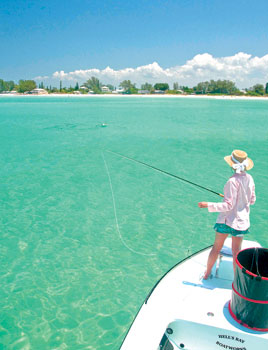It’s tarpon season – show some respect
From the June 23, 2010 Issue
PHOTO/RUSTY CHINNIS
Ann Chiles prepares to make a cast to a school of
tarpon off Anna Maria Island as her guide positions
her with a push pole. Any motor noise electric or
otherwise would alert the fish to her presence.
Tarpon season is here and anglers who rig properly, are patient and show a little respect to the fish and other fishermen can experience one of angling’s greatest pleasures. If you never tried tarpon fishing, the Island has some of the state’s top tarpon guides who can help you experience the thrill of a lifetime. There’s no better way to learn the ins and outs of this demanding sport than fishing with a professional. It is money well spent.
Tarpon will fall for a well placed crab, pinfish, artificial lure or fly, but anglers need to be on top of their game. You’ll hear many fishermen say that they just like to see a tarpon jump when first hooked and are not interested in actually landing them. The reason you hear this is because tarpon are incredibly tough fish and intimidating to people who don’t know how to fight them. If you hook one (on any tackle) and don’t fight it properly, you could be in for a couple of hours of back breaking work. Work them properly from the minute you hook them and you can land them consistently in under half an hour.
The key to catching tarpon quickly (better for the angler and the tarpon) is to know the breaking strength of your leader, rig properly and fight them hard from the strike. It’s important to hold your rod with only a slight bend over the whole length rather than high with a big arch.
Rigging is critical. Tarpon will test your tackle and technique to the limit. One weak link and the game is over. First and foremost you’ll need a reel with a smooth drag. A matching rod, quality line and a well sharpened hook are mandatory!
Learn how to rig a proper tarpon leader. I start by doubling my 20- pound class tippet (the weakest link) and tying it to 70-pound bite tippet using an improved blood knot. It’s critical when tying any knot to wet it and draw it very tight. That way there is no chance of it slipping. I leave my 20-pound tippet on the spool and then measure off about 6 feet of line before clipping it off. I then double the line and tie a Bimini twist. At this point, I trim all the ends and tie my fly on with a non-slip mono loop knot. This same leader can be used with any tackle. To finish, simply twist the two ends of the Bimini and attach to your running line with another improved blood knot. This knot is a bit difficult to tie at first, but it’s a terrific connection. In lieu of the blood knot, a uni-knot can be used.
The best tip for consistent success in tarpon fishing is to exercise patience and be considerate of other anglers. Never run an outboard near tarpon. While it’s possible to catch one this way occasionally, the method spoils the fishing for everyone. When you spot a school of fish, place yourself in their path and wait (motors off) for them to approach. Timing is important. Judge the path of the fish and make a long cast to intercept them. If they track off, or don’t bite, wait until they are well past and make a wide loop around the school to set up again. Stay well away from any boat that is fishing a school. Go around and wait your turn or find another target. If anglers use this method, everyone gets a shot without spooking the fish. Better yet, find a good edge where tarpon travel, and stay there. You will get more quality shots by avoiding the temptation to chase schools of fish.
Unless you’re using a trolling motor and a push pole, never chase tarpon on shallow bars. Even a trolling motor will disturb a school of tarpon if you get too close. Seasoned anglers use their trolling motor to get lined up with an approaching school, cutting the electric motor off and switching to a push pole well in advance of intercepting their path with a presentation. One of the worst things you can do is cut across shallow bars at the passes when other anglers might be stalking a school.
Tarpon fishing is one of the most challenging and exciting experiences in the angling world. Learn to rig properly, be patient and considerate of other anglers and you’ll have the time of your life. Go out unprepared and you’re in for one of the world’s most frustrating experiences.
Local guides:
There are many local guides that can put you on tarpon in area waters.
Mainsail dock (adjacent to Island Discount Tackle):
Captain Randall Fowler, 941-238-8925
Captain Justin Moore, 941-720-6408
Island Discount Tackle:
Captain Tom Chaya, 941-778-4498
Captain Mac Gregory, 941-809-5783.
Fly fishing guides:
Captain Nick Angelo, 1-813-230-8473
Captain Bryon Chamberlin, 1-813-361-8801

